A Century of Change
(This is the introduction to the commemorative program for the “Athletics at Pitt: The Forefront of a Century of Change” centennial celebration of Pitt’s Black athletes. The May 10, 2011, event was held in the Petersen Events Center. Robert Hill is Pitt’s vice chancellor for public affairs.)
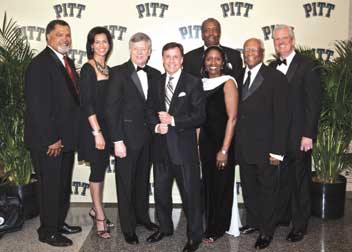 From left, event cochair David Garnett (A&S ‘71), a Pitt football player from 1968 to ’70; CNN news anchor Fredrica Whitfield; Pitt Chancellor Mark A. Nordenberg; NBC sportscaster and event emcee Bob Costas; Brian Salter (A&S ’71), event cochair, Pitt trustee, a Collegiate All-American in Track and Field, a Pitt football player from 1968 to ’70, and an NFL player from 1971 to ’76; Linda Wharton Boyd (A&S ’72, ’75G, ’79G), president of Pitt’s African American Alumni Council; Pitt trustee Herbert P. Douglas Jr. (EDUC ’48, ’50G), a bronze medalist in the long jump at the 1948 Olympics and one of the first three African Americans to play football for Pitt, in 1945; and Steve Pederson, Pitt athletics director.
From left, event cochair David Garnett (A&S ‘71), a Pitt football player from 1968 to ’70; CNN news anchor Fredrica Whitfield; Pitt Chancellor Mark A. Nordenberg; NBC sportscaster and event emcee Bob Costas; Brian Salter (A&S ’71), event cochair, Pitt trustee, a Collegiate All-American in Track and Field, a Pitt football player from 1968 to ’70, and an NFL player from 1971 to ’76; Linda Wharton Boyd (A&S ’72, ’75G, ’79G), president of Pitt’s African American Alumni Council; Pitt trustee Herbert P. Douglas Jr. (EDUC ’48, ’50G), a bronze medalist in the long jump at the 1948 Olympics and one of the first three African Americans to play football for Pitt, in 1945; and Steve Pederson, Pitt athletics director.It is clear to Pitt Panther fans and even to casual observers of University of Pittsburgh football and basketball that the presence of African American student-athletes in Panther revenue sports is prominent, commonplace, and often game changing. And we take for granted that Blacks on the women’s basketball team and on the track and field team will continue to contribute at spectacular levels.
What is less well known is that the journey of Black Pitt varsity athletes started 124 years after Pitt’s establishment in 1787 as the Pittsburgh Academy. The saga began 18 years after mathematical genius William Hunter Dammond became the first African American to earn a bachelor’s degree from Pitt in 1893, in engineering with honors.
Although an 1899 Western University of Pennsylvania (today’s Pitt) football photograph includes a kneeling Black trainer known simply as Jim, it was only a century ago, in 1911, that Harry Ray Wooten of Oakdale, Pa., and Hubbard Hollensworth of Owego, N.Y., graduated as the University of Pittsburgh’s first Black varsity student-athletes. Not much is known about either. But the 1911 Pitt Owl yearbook does document Wooten’s performance at track meets of the day. And the July 29, 1911, Pittsburgh Courier reported that Hollensworth and nine others established the Schenley Heights Tennis Club, also in 1911, in Pittsburgh’s Hill District.
Wooten and Hollensworth could not have known that their trailblazing membership on Pitt’s track and field team would forge a path for 100 years of African American Pitt student-athlete successors in not only track and field and the aforementioned football and basketball, but also in soccer, baseball, softball, swimming and diving, wrestling, squash, tennis, volleyball, gymnastics, and field hockey. Today, there are more than 500 living African American men and women who have represented Pitt as varsity athletes.
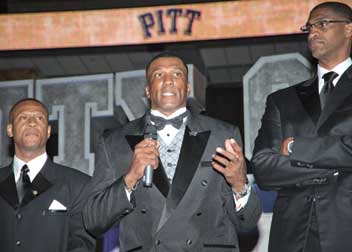 From left, Curtis Aiken (CGS ’87), Pitt basketball star from 1983 to ’87 and Pitt men’s basketball broadcaster; Roger Kingdom (CGS ’02), Pitt football and track star, winner of two Olympic gold medals (1984 and 1988) in the 100 meter hurdles; and Charles Smith (A&S ’88), Pitt men’s basketball career-scoring leader and retired NBA player.
From left, Curtis Aiken (CGS ’87), Pitt basketball star from 1983 to ’87 and Pitt men’s basketball broadcaster; Roger Kingdom (CGS ’02), Pitt football and track star, winner of two Olympic gold medals (1984 and 1988) in the 100 meter hurdles; and Charles Smith (A&S ’88), Pitt men’s basketball career-scoring leader and retired NBA player.Still, it all began with track and field, setting the stage for Pitt Olympians John Woodruff to win the gold in the 800 meters in 1936; Herb Douglas to win the bronze in the long jump in 1948; Arnold Sowell to place fourth in the 800-meter race in 1956; and Roger Kingdom, Pitt’s greatest international athlete of all time, to win the Olympic gold twice in the 110-meter high hurdles, in 1984 and again in 1988.
And the best female Pitt athlete, triple jump queen Trecia-Kaye Smith, won seven NCAA titles and 14 Big East titles.
In football, Pitt history was made again when Jimmy Joe Robinson, joined weeks later by Herb Douglas and Allen Carter, became Pitt’s first Black varsity football player in 1945. In 1953, Henry “Model T” Ford became Pitt’s first Black quarterback. And, over the strong protests of the Georgia governor, Pitt’s Bob Grier made national headlines in 1956 as the first Black student to play in the Sugar Bowl, against Georgia Tech.
But 20 years later and without protest in 1976, Tony Dorsett—the greatest football Panther in history—won the Heisman Trophy as America’s best football player, led the Panthers to their national championship win in the Sugar Bowl against Georgia, and compiled a total of 6,526 yards at Pitt. He has been inducted into the college and professional football halls of fame.
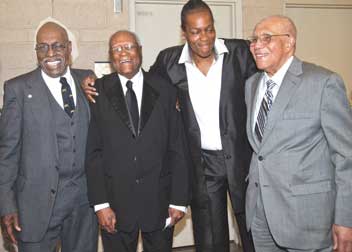 Bobby Grier (KGSB ’57), first African American to play in the Sugar Bowl, in 1956; Herbert P. Douglas Jr.; Wanda Randolph (A&S ’80), holder of Pitt women’s basketball’s single season rebounding record, and Rev. James “Jimmy Joe” Robinson (A&S ’51), Pitt’s first African American football recruit.
Bobby Grier (KGSB ’57), first African American to play in the Sugar Bowl, in 1956; Herbert P. Douglas Jr.; Wanda Randolph (A&S ’80), holder of Pitt women’s basketball’s single season rebounding record, and Rev. James “Jimmy Joe” Robinson (A&S ’51), Pitt’s first African American football recruit. Nearly 30 years after Dorsett’s greatest varsity triumph, Larry Fitzgerald was runner-up for the Heisman in 2003 as a Pitt sophomore wide receiver.
Yet another milestone was achieved for Black Pitt student-athletes when Pitt’s men’s varsity basketball program placed Julius Pegues as a starter on the team in 1955. He and Charles Smith—Pitt’s all-time leading men’s scorer and a 1988 Olympics bronze medalist—could not have predicted that an all-Black team would capture a No. 1 seed in the 2011 NCAA men’s basketball tournament.
During the 1970s, ’80s, and ’90s, women standouts Wanda Randolph, Jennifer Bruce, Debbie Lewis, and Lorri Johnson—Pitt’s all-time leading women’s scorer—integrated Pitt women’s basketball. Perhaps they inspired Shavonte Zellous in 2010 to score the most points in a season in Pitt women’s basketball history.
Appointed by Pitt Alumni Association African American Alumni Council President Linda Wharton Boyd, A Century of Change banquet chair Herb Douglas and cochairs Dave Garnett, Bryant Salter, and Jennifer Bruce Scott led a celebration of 100 years of achievements by African American varsity student-athletes that few universities can claim. These heroes may be regarded as Pitt’s great Black Panthers.
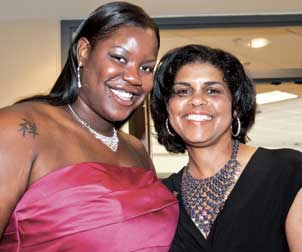 Marcedes Walker (CGS ’08), all-time leading rebounder in Pitt women’s basketball history, and Jennifer Bruce Scott (NURS ‘86), event cochair, second all-time leading scorer in Pitt women’s basketball history, and 1985 Kodak All-American.
Marcedes Walker (CGS ’08), all-time leading rebounder in Pitt women’s basketball history, and Jennifer Bruce Scott (NURS ‘86), event cochair, second all-time leading scorer in Pitt women’s basketball history, and 1985 Kodak All-American.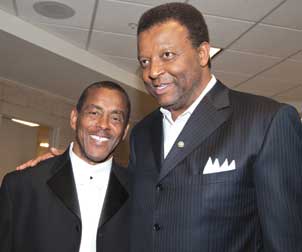 From left: Tony Dorsett (A&S ’77), NFL Hall of Famer, three-time first team All-American, and Heisman Trophy winner; and William R. “Billy” Knight (A&S ’74), men’s basketball All-American, 11-year NBA veteran.
From left: Tony Dorsett (A&S ’77), NFL Hall of Famer, three-time first team All-American, and Heisman Trophy winner; and William R. “Billy” Knight (A&S ’74), men’s basketball All-American, 11-year NBA veteran. 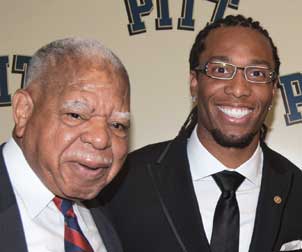 Justin M. Johnson, retired Superior Court of Pennsylvania judge, and Larry Fitzgerald (A&S ’06), Pitt football player from 2002 to ’04, wide receiver for Arizona Cardinals.
Justin M. Johnson, retired Superior Court of Pennsylvania judge, and Larry Fitzgerald (A&S ’06), Pitt football player from 2002 to ’04, wide receiver for Arizona Cardinals.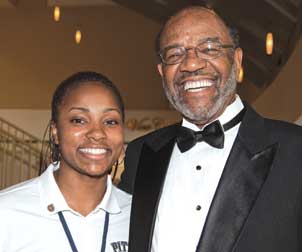 Ashlee Anderson, Pitt sophomore and women’s basketball team member, and Julius Pegues (ENGR ’59), Pitt’s first African American men’s basketball player.
Ashlee Anderson, Pitt sophomore and women’s basketball team member, and Julius Pegues (ENGR ’59), Pitt’s first African American men’s basketball player.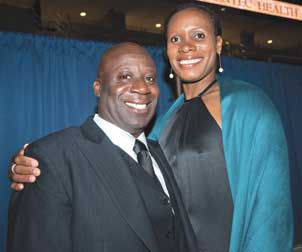 Lee McRae (CGS ’88), three-time NCAA Indoor Champion in the 55 meters, and Trecia-Kaye Smith (EDUC ’99, SHRS ’02), Pitt track star from 1996 to ’99, seven-time NCAA national champion in the long jump and triple jump.
Lee McRae (CGS ’88), three-time NCAA Indoor Champion in the 55 meters, and Trecia-Kaye Smith (EDUC ’99, SHRS ’02), Pitt track star from 1996 to ’99, seven-time NCAA national champion in the long jump and triple jump.Other Stories From This Issue
On the Freedom Road

Follow a group of Pitt students on the Returning to the Roots of Civil Rights bus tour, a nine-day, 2,300-mile journey crisscrossing five states.
Day 1: The Awakening
Day 2: Deep Impressions
Day 3: Music, Montgomery, and More
Day 4: Looking Back, Looking Forward
Day 5: Learning to Remember
Day 6: The Mountaintop
Day 7: Slavery and Beyond
Day 8: Lessons to Bring Home
Day 9: Final Lessons

